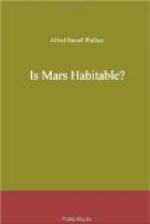Note on Professor Lowell’s article in the Philosophical Magazine; by J.H. Poynting, F.R.S., Professor of Physics in the University of Birmingham.
“I think Professor Lowell’s results are erroneous through his neglect of the heat stored in the air by its absorption of radiation both from the sun and from the surface. The air thus heated radiates to the surface and keeps up the temperature. I have sent to the Philosophical Magazine a paper in which I think it is shown that when the radiation by the atmosphere is taken into account the results are entirely changed. The temperature of Mars, with Professor Lowell’s data, still comes out far below the freezing-point—still further below than the increased distance alone would make it. Indeed, the lower temperature on elevated regions of the earth’s surface would lead us to expect this. I think it is impossible to raise the temperature of Mars to anything like the value obtained by Professor Lowell, unless we assume some quality in his atmosphere entirely different from any found in our own atmosphere.” J.H. POYNTING. October 19, 1907.
CHAPTER VI.
A NEW ESTIMATE OF THE TEMPERATURE OF MARS.
When we are presented with a complex problem depending on a great number of imperfectly ascertained data, we may often check the results thus obtained by the comparison of cases in which some of the more important of these data are identical, while others are at a maximum or a minimum. In the present case we can do this by a consideration of the Moon as compared with the Earth and with Mars.
Langley’s Determination of the Moon’s Temperature.
In the moon we see the conditions that prevail in Mars both exaggerated and simplified. Mars has a very scanty atmosphere, the moon none at all, or if there is one it is so excessively scanty that the most refined observations have not detected it. All the complications arising from the possible nature of the atmosphere, and its complex effects upon reflection, absorption, and radiation are thus eliminated. The mean distance of the moon from the sun being identical with that of the earth, the total amount of heat intercepted must also be identical; only in this case the whole of it reaches the surface instead of one-fourth only, according to Mr. Lowell’s estimate for the earth.
Now, by the most refined observations with his Bolometer, Mr. Langley was able to determine the temperature of the moon’s surface exposed to undimmed sunshine for fourteen days together; and he found that, even in that portion of it on which the sun was shining almost vertically, the temperature rarely rose above the freezing point of water. However extraordinary this result may seem, it is really a striking confirmation of the accuracy of the general laws determining temperature which I have endeavoured to explain in the preceding chapter. For the same surface which has had fourteen




